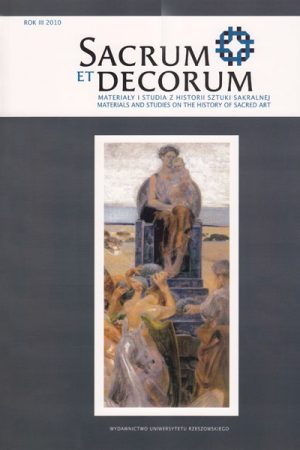A Memorial by Cyprian Godebski over the Ocean, a Swan Song of Academic Religious Sculpture
Keywords:
ACADEMIC ART, BRITTANY, CYPRIAN GODEBSKI, EX-VOTO, GREAT EMIGRATION, RELIGIOUS SCULPTUREAbstract
Cyprian Godebski is the author of numerous monuments and tombstones, among others in Austria, Belgium and Russia, but he worked primarily in France. His works can be found in Paris (the best known among them are the headstones of H. Berlioz and Th. Gautier), Monte Carlo and Brittany. Probably the biggest extant work by Godebski, little known in Poland, is the stone group Madone des naufragés [Our Lady of the Shipwrecked] on the Atlantic promontory Pointe du Raz in the westernmost region of Brittany. Godebski, who spent most of his life in France, was connected with numerous ties to this region. Apart from this group, the most visible of this relationship is the bronze monument to general A. Le Flo, Godebski's friend from St. Petersburg (the general was a French ambassador there) in the main square in Lesneven near Brest (1899). Our Lady of the Shipwrecked (1901), commissioned from Godebski by Count de Trobriand, was going to be a private memorial to local sailors, modelled on several similar ex-votos on the shores of Brittany. However, the republican departmental authorities did not issue a permit to erect a religious monument in a public place. The refusal of the authorities was connected with the approaching decision about the separation between Church and state in France. The conflict was particularly severe in Brittany, which was considered the stronghold of traditional Catholicism, but it was also the home country of the philosopher Ernest Renan, an Anti-Christ in the eyes of some right-wing circles. The conflict escalated in 1903, when the so-called sardine crisis hit very badly Breton fishermen and various political camps, including the Catholic Church, tried to use it to expand their influence. Finally Godebski's sculpture was erected thanks to the determination of the Bishop of Quimper, to whom it was presented by the artist as a votive sculpture in memory of his son's death in Tonkin. Our Lady of the Shipwrecked was created in 1901-1903 in Carrara. The ceremonial inauguration of the figure, accompanied by a Mass, took place on 3rd July 1904. It was attended by approximately 20 - 30 000 pilgrims and the bishop attending the celebration paid tribute to Godebski. Madone des naufragés follows ancient tradition of placing crosses and religious figures on mountain tops and coastal rocks. We can find a particularly large number of colossal religious figures in the French sculpture of the 19th century, especially from the period of the religious awakening supported by the government of the Second Empire. Our Lady of the Shipwrecked differs, however, from the huge statues of the Virgin Mary erected at that time in France through its strong realism and lack of obvious allusions to Romanesque, Gothic or Baroque depictions. In contrast to his predecessors, the creators of large, static allegories or saints' figures, Godebski portrayed almost a genre scene. However, what makes Our Lady of the Shipwrecked special, are the non-artistic factors described above. It was erected in the heat of the political and religious fight in France, when the secular Republic was on an anti-Church offensive, leading to fundamental legal decisions. Did the artistic concept of the sculpture, including the undoubtedly most interesting solution of the emotional tension between the sailor and the child Jesus was consciously adopted by Godebski because of this conflict? We do not know that. The creation of the sculpture was initiated by lay people, but finally it was executed under the patronage of the Church, and it eventually turned into a new place of worship of the Virgin Mary in Brittany.Downloads
Downloads
Published
How to Cite
Issue
Section
License
Copyright (c) 2010 Sacrum et Decorum

This work is licensed under a Creative Commons Attribution-NonCommercial-NoDerivatives 4.0 International License.
In line with the Open Access policy, authors retain full copyright to their articles – without restrictions.
Authors can deposit their articles in a repository of their choice.


